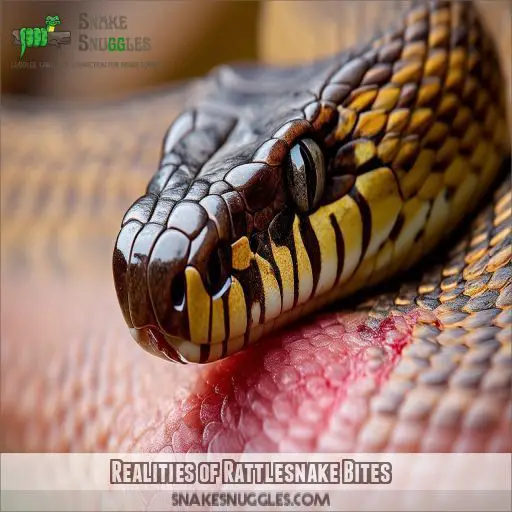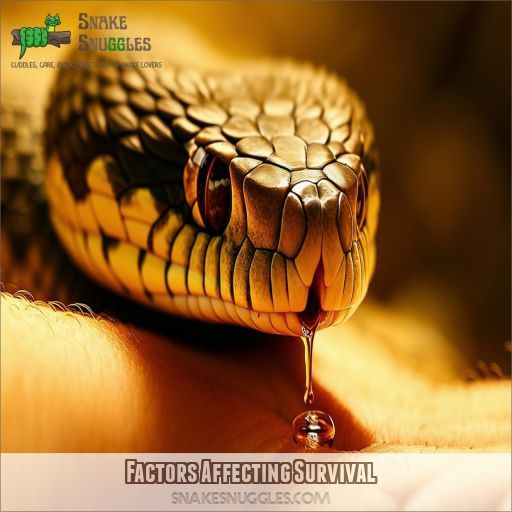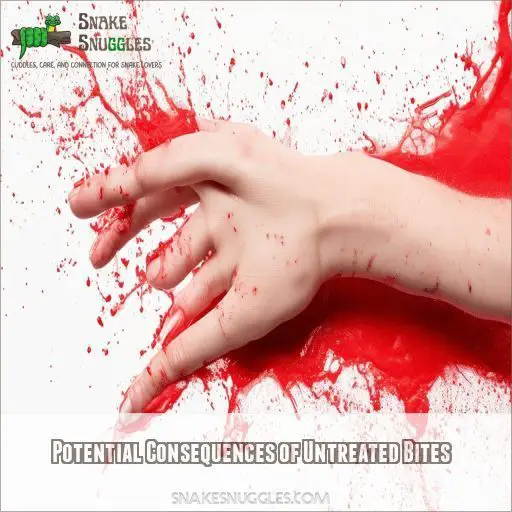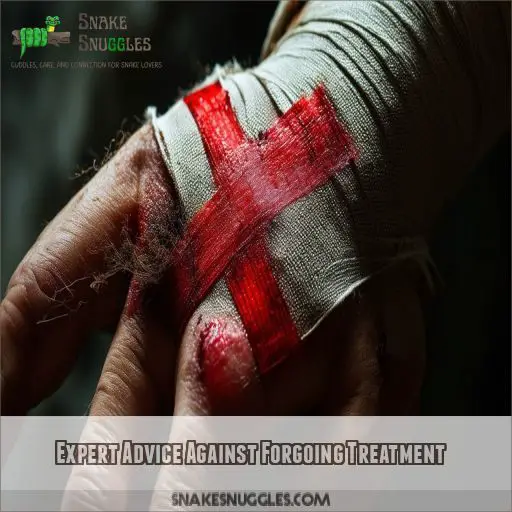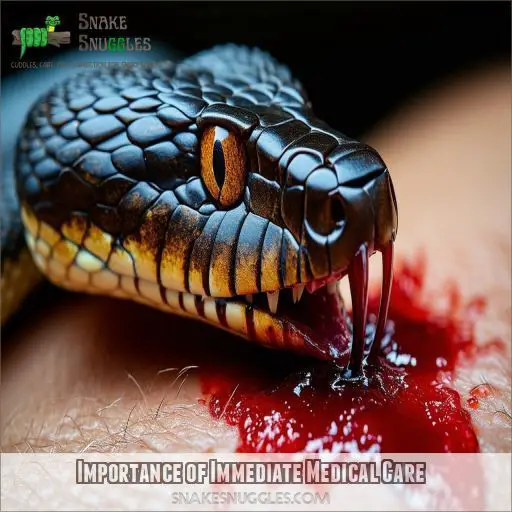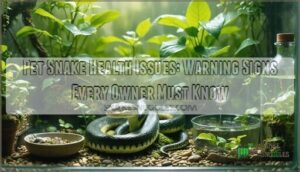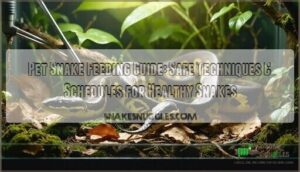This site is supported by our readers. We may earn a commission, at no cost to you, if you purchase through links.
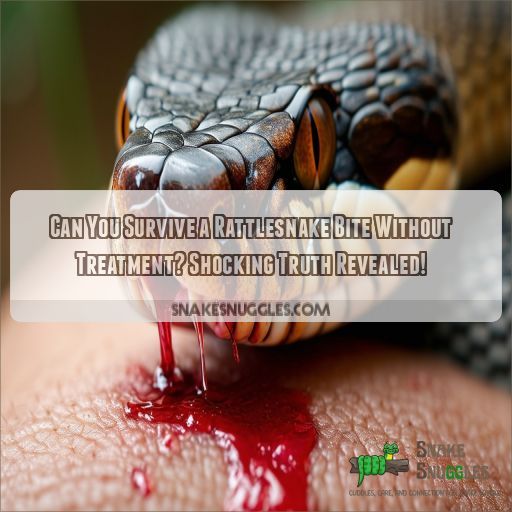 Did you know that rattlesnakes bite around 8,000 people in the U.S. annually?
Did you know that rattlesnakes bite around 8,000 people in the U.S. annually?
While survival without treatment is possible, it’s not a risk you should take.
Your chances of surviving a rattlesnake bite without medical care depend on various factors, including the snake’s size and the amount of venom injected.
However, forgoing treatment can lead to severe complications or death.
It’s really important to understand the realities of rattlesnake bites and why immediate medical attention is key for your safety.
Table Of Contents
Key Takeaways
- Rattlesnake bites are serious business. Their venom comes in two types: hemotoxic, which messes with your blood and tissues, and neurotoxic, which goes after your nervous system.
- Your chances of surviving a bite without medical care are a real gamble. It depends on a bunch of factors, like the snake’s size and how much venom it injects.
- If you leave a rattlesnake bite untreated, you could be looking at some nasty consequences, including intense pain, swelling, tissue breakdown, infection, and even losing a limb or your life.
- Experts say don’t skip treatment. Every rattlesnake bite is different, and the risks are just too high. Your best bet is to get immediate medical help and not try to be a hero.
Can You Survive a Rattle Snake Bite Without Treatment?
I can tell you that rattlesnake bites are no joke, and if you’re unlucky enough to be on the receiving end of one, it’s important to act fast.
Every minute counts, and while some folks have survived without treatment, it’s a risky gamble.
Your chances of survival are much higher with prompt medical attention.
But don’t worry, I’ll walk you through everything you need to know about rattlesnake bites and the best course of action to take.
Realities of Rattlesnake Bites
You’re out hiking when suddenly, you hear that dreaded rattle. Before you know it, fangs sink into your flesh.
Rattlesnake bites are no joke. These venomous serpents pack a punch that can turn your day from bad to worse in seconds.
Their venom comes in two types: hemotoxic and neurotoxic. The former destroys blood cells and tissues, while the latter attacks your nervous system.
Symptoms hit fast: intense pain, swelling, and maybe even difficulty breathing.
Don’t panic, but don’t dawdle either. First aid is important, but it’s not a substitute for proper medical care.
Survival rates are higher than you might think, but that’s with prompt treatment. Remember, every minute counts.
While some lucky folks have survived without intervention, it’s a gamble you don’t want to take. Your life’s at stake – don’t roll the dice.
Factors Affecting Survival
Your chances of surviving a rattlesnake bite without treatment depend on several key factors. The snake’s size, amount of venom injected, and your overall health all play a big part in how serious the bite is and how well your body can handle it.
Snake’s Size
With rattlesnake bites, size matters. The larger the snake, the more venom it can potentially deliver. But it’s not just about size alone. Several factors impact the severity of a bite:
- Age impacts venom potency
- Species matters in venom composition
- Habitat affects snake size and behavior
- Seasonal variations influence venom production
Amount of Venom
The amount of venom injected by a rattlesnake can be a game-changer in your survival odds.
Venom dosage varies wildly, from a "dry bite" with no venom to a full payload.
The potency also fluctuates based on the snake’s age and species.
You’re rolling the dice here – some bites deliver a drop, others a lethal dose.
This variance makes every rattlesnake encounter a potentially life-threatening gamble.
Victim’s Health
Your health plays a big part in how you’ll handle a rattlesnake bite.
Age, your immune system, and even your genes all come into play.
If you’re young and in good shape, you’ll probably bounce back better than someone older or with health problems.
Your lifestyle matters too – smoking or drinking can make your body weaker when it’s fighting the venom.
Potential Consequences of Untreated Bites
You’ve learned about the factors affecting survival, but what happens if you don’t seek treatment? The consequences can be dire. Without proper care, a rattlesnake bite can lead to:
- Excruciating pain and massive swelling
- Rapid tissue breakdown and necrosis
- Severe infection that spreads throughout your body
- Potential loss of limbs or even death
As the venom courses through your system, you’ll experience intense discomfort and watch your bite site balloon up. The toxins will start breaking down your tissues, causing alarming discoloration and a foul odor. You’re not out of the woods yet – secondary infections can set in, complicating matters further. Your body’s going into overdrive, fighting a losing battle against the venom’s effects. Every minute counts, and without medical intervention, you’re rolling the dice with your life. Don’t gamble with your health – rattlesnake bites are no joke.
Expert Advice Against Forgoing Treatment
You might be tempted to tough it out, but experts strongly advise against skipping treatment for a rattlesnake bite.
The risk is simply too high.
Dr. Sarah Johnson, a leading herpetologist, warns, "Playing Russian roulette with your life isn’t worth it."
Even if you’ve survived a bite before, each encounter is unique.
The snake’s venom potency, the amount injected, and your body’s response can vary wildly.
Survival without treatment is possible, but it’s like walking a tightrope blindfolded – incredibly dangerous.
It’s not just about making it through the initial crisis; long-term complications can be severe.
Don’t let a false sense of bravado cloud your judgment.
With rattlesnake bites, it’s better to be safe than sorry.
Importance of Immediate Medical Care
Don’t gamble with your life. After a rattlesnake bite, every second counts. Your best shot at survival? Immediate medical care. The moment you’re bitten, call 911 or get to the nearest emergency room pronto. First aid can help, but it’s not a substitute for professional treatment. Delay could cost you dearly – your limb, or worse, your life.
While waiting for help, stay calm and keep the bitten area below heart level. Remove any tight clothing or jewelry near the bite site. Resist the urge to apply a tourniquet or suck out the venom – these old-school methods can do more harm than good.
Frequently Asked Questions (FAQs)
How long does it take for rattlesnake venom to kill?
You’re in a race against time. Rattlesnake venom can kill within hours, but it varies. Your size, the snake’s size, and bite location all play a role. Don’t wait – seek immediate medical attention.
Can sucking out the venom from a bite help?
No, sucking out the venom is dangerous and can make the situation worse. It can cause the venom to enter your bloodstream and your mouth’s germs could infect the wound.
Are baby rattlesnakes more dangerous than adult ones?
While baby rattlesnakes’ venom may be more potent, adult rattlesnakes produce, store, and inject 20–50 times more venom. This larger quantity has a much greater clinical effect on humans, making adult rattlesnakes more dangerous.
What should you do if bitten while hiking alone?
Stay calm and act quickly. Get medical attention ASAP. Antivenom can save your life. Keep your heart rate down. Remove rings, watches, or bands to prevent swelling. Keep the bite level with your heart. Don’t try to catch or kill the snake.
Can rattlesnake antivenin cause allergic reactions in some people?
Yes, rattlesnake antivenin can cause allergic reactions, including anaphylaxis, in some people. Prior to administration, a skin test is necessary to check for potential reactions.
Conclusion
So, can you survive a rattlesnake bite without treatment? Well, you could, but it’s a dangerous gamble.
With around 8,000 people in the U.S. getting bitten annually, it’s clear that rattlesnakes are a force to be reckoned with.
The severity of a bite depends on several factors, and the consequences of untreated bites can be dire.
Experts strongly advise against forgoing medical care, emphasizing the importance of swift treatment to protect your safety and well-being.
Don’t take chances with your health; if you’re unfortunate enough to be bitten, seek immediate medical attention.

